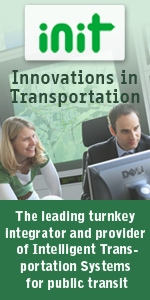

| In This Issue |
| » BREAKING NEWS |
| » NEWS HEADLINES |
| » IN DEPTH: TECHNOLOGY |
| » APTA NEWS |
| » TELLING OUR STORY |
| » COMMENTARY |
| » PEOPLE ON THE MOVE |

Check out the classifieds for numerous transit career opportunities including a chief executive officer!
| IN DEPTH: TECHNOLOGY |
Innovations in Transit Technology: Making Plans for Future Operations
BY LINDA BOHLINGER, Vice President, HNTB, Santa Ana, CA, and APTA Vice Chair-Research and Technology
Transit Technology refers to focusing on ways to apply existing technology in innovative ways, such as real-time data,  customer-developed data applications, and augmented reality. I’d like to highlight some of these new technologies and what we can look for in the future.
customer-developed data applications, and augmented reality. I’d like to highlight some of these new technologies and what we can look for in the future.
Most large transit properties now have Automatic Vehicle Locator (AVL), fleet management, dispatch, and fare collection systems. Growing numbers of vendors supply products for public transit agencies of all sizes. Now they are focused on sharing this information with their traveling public.
We’re getting better at using the technology and the data in real time. Google Transit is so popular with transit agencies that Google had to shut down the application process and has recently reopened it—with a wait of three to four months for transit agencies to be added to the service.
The public transit industry is also working on mobile device versions, such as iPhone apps, providing static information as well as dynamic real-time information. Multi-modal Portland, OR, not surprisingly, was out in front on this with several transit apps, including PDXBus, which uses live tracking information from the Tri-County Metropolitan Transportation District of Oregon to display arrival times; cleverly, it also turns the iPhone into a flashing beacon to signal bus drivers to stop.
Another new trend called “crowd sourcing” means that transit agencies make raw information available, and the public develops applications leveraging it.
We’re also about to enter the “augmented reality” era in transit station mapping. “New York Nearest Subway” will allow users to hold the phone up to a street and have the nearest stations displayed, hovering in the air in the view of the actual streetscape.
Another new application is “Where's My Bus?®” on the Dallas Area Rapid Transit mobile web site. This feature, currently in the testing stage, provides an actual estimated time for the next bus information at a specific stop.
Texting is an increasingly popular means of communication and can be used even on devices that don’t have mobile browsers. The research firm Nielsen reports that more than three-quarters of U.S. wireless subscribers have texting capability and that mobile subscribers send and receive more text messages per month than they do phone calls.
BART is beta testing a new service to provide riders with train arrivals, delay advisories, elevator status, and other information on-demand by SMS (short-message service) text messages.
Social networks have exploded in popularity and their adoption continues to rise. Transit agencies are actively looking into ways to share their information through outlets such as Twitter, Facebook, etc.
“Dynamic ads” are also on the rise. The consumer receives only advertisements that refer to stores or restaurants in close proximity to the location of the train or bus. The technique gives the interested customer the possibility to leave the transit vehicle and visit the advertised establishment at the next stop.
Another Intelligent Transportation Systems user service is electronic payment services. The technology is so good and advanced that it can hardly keep up with the ways to apply it—limited only by your imagination.
Miami-Dade Transit is giving away thousands of its new EASY Cards: reloadable, debit-like cards that public transit riders will be able to use instead of cash when taking Metrorail, Metrobus, or Metromover.
Global Positioning Satellite systems that previously cost $4,000 can now be ported to rugged Blackberries with the same functionality for as little as $400
Transit agencies increasingly turn to video surveillance to fight crime and terrorism and the burden on security personnel is growing. “Monitoring video screens is boring, mesmerizing, and has no intellectually engaging stimuli,” in the words of a report from the University of South Florida Center for Urban Transportation Research that looks at the use of smart video for detecting threats and criminal activity on transit properties.
Another growing trend is “green is good.” In September 2009, 43 Green Transit projects received $100 million in federal TIGGER grants supporting use of cutting-edge environmental technologies.
What else is in the future of public transit technology?
Cloud computing, which allows large companies to host data centers, reduces overhead costs dramatically. It’s a very new technology—untested and still risky—but probably will be adopted generally within the next five years.
Finally, our transit customers are increasingly connected through mobile phones. Our customers will be in charge of how they want to see and use our data.
Welcome to the future.
| « Previous Article | Return to Top | Return to Main | Next Article » |
|
||||||
| AMERICAN PUBLIC TRANSPORTATION ASSOCIATION |
Telephone (202) 496-4800 • Fax (202) 496-4321
Search Back Issues